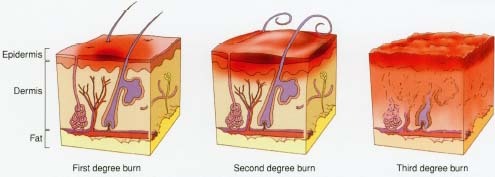Burns
Burns are tissue injuries caused by fire, sun, steam, hot fluids, heated objects, electricity, lightning, radiation, and other things. Burns may cause a variety of problems ranging from minor discomfort to serious life-threatening conditions.
KEYWORDS
for searching the Internet and other reference sources
Dermatology
Epithelium
Rehabilitation
Trauma
Wounds
Why Are Burns a Hot Topic?
The skin is the protective outer surface of the body. Its outer layer is the epidermis, comprising several layers of epithelial cells arranged like shingles on a roof. Its inner layer is the dermis, which contains many types of nerves that sense touch, pain, heat, and cold. Healthy skin renews itself and helps keep body fluids in and unwanted bacteria out. When burns injure the skin, they upset these processes. All burns result in skin cell injury. The most serious burns can result in death.
What Are the Three Classes of Burns?
First degree burns
These burns are the least severe. They affect only the top layer of skin, the epidermis, which turns red at the burn site and hurts when it is touched. First degree burns sometimescause small blisters and mild swelling, but they usually heal rapidly on their own.
Did You Know?
The U.S. National Institute of General Medical Sciences reports that there are more than 2 million burn injuries requiring medical attention each year. Among people with burn injuries:
- 70,000 require hospitalization
- 20,000 require treatment in special burn units
- 10,000 die of burn-related infections
- burn research and burn treatments are improving survival rates even among people with burns covering more than 90% of their bodies.
Second degree burns
These burns affect both the dermis and the epidermis. They often cause pain, fever, swelling, chills, and blisters,

Third degree burns
These are the most serious burns and require immediate medical treatment. They affect all layers of skin and cause damage and cell death to all kinds of tissues, including nerves, sweat glands, fat, and hair follicles. The burn area itself may be free from pain if its nerve endings have been damaged, but the area around the burn will often be extremely painful. The whitish or reddish blisters of second degree burns usually will not be present, but the skin may be blackened or charred. Other complications of third degree burns may include:
- loss of body fluids (dehydration)
- respiratory (breathing) problems
- bacterial infections and pneumonia
- shock.
Sunburns
These things can help ease the discomfort of sunburns:
- cool baths or cool compresses
- soothing lotions
- over-the-counter pain medications such as acetaminophen.
These things can make sunburns worse:
- petroleum jelly
- butter
- harsh soaps
- over-the-counter sprays containing benzocaine.
Severe sunburn should be treated by a doctor.
How Do Doctors Treat Burns?
Treatment depends on how large the burn is and how deeply it has injured skin tissue and underlying organs. Mild burns usually heal on their own when the injured area is kept clean and dry. More serious burns often require treatment in a hospital. The most serious burns may require treatment in a hospital's specialized burn unit or in an intensive care unit. These burns often require skin graft surgery to replace the damaged tissue followed by a long healing period and physical therapy for the injured area. Fire safety, awareness, and prevention are the best defenses against burns.
See also
Skin Conditions
Shock
Trauma
Resources
U.S. National Institute of General Medical Sciences, 45 Center Drive,
MSC 6200, Bethesda, MD 20892-6200. The NIGMS posts resource lists and
fact sheets about burns and other injuries at its website.
http://www.nih.gov/nigms
American Burn Association, 625 North Michigan Avenue, Suite 1530,
Chicago, IL 60611. The ABA publishes a
Journal of Burn Care and Rehabilitation
and posts burn statistics and a reference bibliography at its website.
http://ameriburn.org
Comment about this article, ask questions, or add new information about this topic: